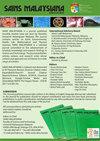Lunasin对偶氮甲烷和葡聚糖硫酸钠诱导的小鼠结肠中KI67、BCL-2和C-MYC表达的抑制作用
IF 0.8
4区 综合性期刊
Q3 MULTIDISCIPLINARY SCIENCES
引用次数: 0
摘要
由于副作用小、效率高、成本低,使用药物治疗癌症一直很重要。大豆中的Lunasin被认为是潜在的化学预防剂。本研究旨在研究和研究lunasin在偶氮甲烷(AOM)和葡聚糖硫酸钠(DSS)诱导的小鼠中化学预防作用的作用机制。将总共30只BLAB/c小鼠分为六组。在其中五个组(阴性对照组、阳性对照组和三个干预组)中,用AOM和DSS诱导癌变;第六组未接受干预。干预组接受不同剂量的低剂量Lunasin(75 mg/kg体重)、中剂量Lunasiin(150 mg/kg体重)和高剂量Lunasine(200 mg/kg体重)。进行免疫组织化学以测量Ki67、C-myc和Bcl-2在处死小鼠的远端结肠中的表达。对样品进行显微镜评估和拍照,并使用Image J应用程序进行细胞计数。此外,使用H-核心方法来定量Ki67、C-myc和Bcl-2的表达。结果表明,在75 mg/kg体重和150 mg/kg体重的lunasin剂量水平下,阴性对照组和干预组之间存在显著差异(p<0.05)。这表明Lunasin在AOM和DSS诱导的结肠小鼠中抑制增殖并诱导细胞凋亡。本文章由计算机程序翻译,如有差异,请以英文原文为准。
The Effect of Lunasin on Inhibition of KI67, BCL-2 and C-MYC Expression in Azoxymethane and Dextran Sodium Sulfate Induced Mice Colon
Treatment of cancer using medicinal-plant based has been important due to minimal side effects, high efficiency and low cost. Lunasin from soybean is known as potential chemopreventive agent. This study aimed to study and investigate the proteins involved in the mechanisms of action of lunasin underlie its chemopreventive effects in Azoxymethane (AOM) and Dextran Sodium Sulfate (DSS) induced mice. A total 30 BLAB/c mice were separated into six groups. In five of the groups - a negative control group, positive control group, and three intervention groups - carcinogenesis was induced with AOM and DSS; the sixth group received no interventions. Lunasin were given in different doses of Low Dose Lunasin (75 mg/kgBW), Moderate Dose Lunasin (150 mg/kgBW), and High Dose Lunasin (200 mg/kgBW) to intervention groups. Immunohistochemistry was conducted to measure Ki67, C-myc, and Bcl-2 expressions from the distal colons of mice that had been sacrificed. The samples were microscopically assessed and photographed, and cell counts were performed using the Image J application. Further, the H-score method was used to quantify of Ki67, C-myc and Bcl-2 expressions. The results of this show that there is significant differences between the negative control and the intervention groups were found at the 75 mg/kgBW and 150 mg/kgBW (p < 0.05) lunasin dosage levels. This demonstrates that Lunasin inhibits proliferation and induces apoptosis in the colon mice induced by AOM and DSS.
求助全文
通过发布文献求助,成功后即可免费获取论文全文。
去求助
来源期刊

Sains Malaysiana
MULTIDISCIPLINARY SCIENCES-
CiteScore
1.60
自引率
12.50%
发文量
196
审稿时长
3-6 weeks
期刊介绍:
Sains Malaysiana is a refereed journal committed to the advancement of scholarly knowledge and research findings of the several branches of science and technology. It contains articles on Earth Sciences, Health Sciences, Life Sciences, Mathematical Sciences and Physical Sciences. The journal publishes articles, reviews, and research notes whose content and approach are of interest to a wide range of scholars. Sains Malaysiana is published by the UKM Press an its autonomous Editorial Board are drawn from the Faculty of Science and Technology, Universiti Kebangsaan Malaysia. In addition, distinguished scholars from local and foreign universities are appointed to serve as advisory board members and referees.
 求助内容:
求助内容: 应助结果提醒方式:
应助结果提醒方式:


